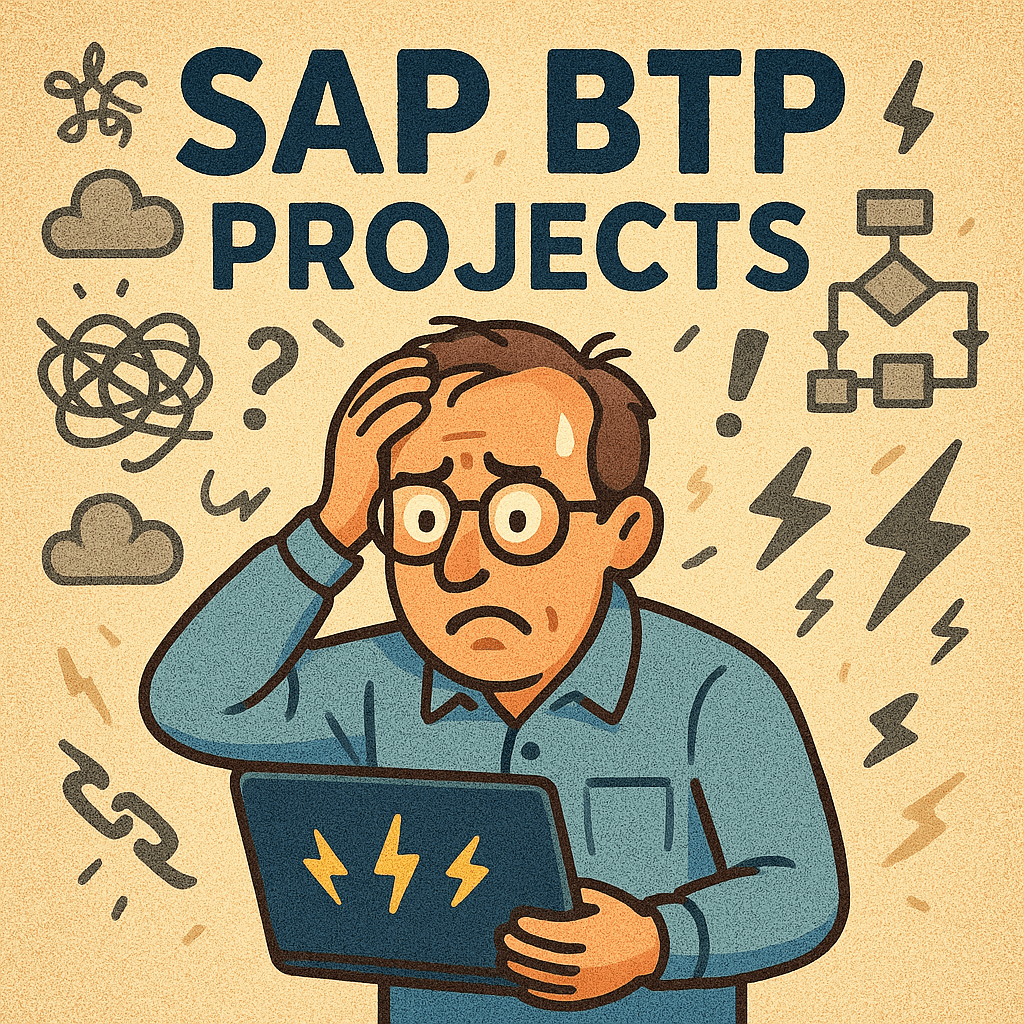SAP Business Technology Platform (BTP) is packed with possibilities. It helps businesses build apps, automate processes, integrate systems, and leverage AI and do much more – all without modifying the core ERP. But with so many possibilities, projects can easily run into challenges—some of which don’t become obvious until it’s too late.
From scope creep and missing APIs to talent gaps, poor project management, and user adoption issues, there are plenty of reasons why BTP projects don’t always go as planned. While not all of these lead to outright failure, they can cause delays, cost overruns, or solutions that don’t quite meet expectations that is necessary for user adoption.
Let’s break down some of the biggest challenges and how to handle them before they derail your project.
Scope Overload: When BTP’s Flexibility Becomes a Challenge
One of the best things about SAP BTP is that it lets you build almost anything. But that’s also a huge risk.
Because BTP enables custom apps, integrations, automation, and AI, clients and end users often expect too much. Midway through the project, new ideas pop up, additional features get added, and suddenly the project has grown beyond the original budget and timeline.
I’ve seen this happen often. It doesn’t always mean failure, but it can lead to disappointment and resistance to adoption if users feel like they didn’t get everything they expected.
How to prevent this?
- Lock down must-have vs. nice-to-have features early on.
- Break projects into phases, proof of concepts, prototypes or MVPs (Minimum Viable Products).
- Set realistic expectations about what’s possible within the budget and more importantly communicate that and get alignment.
Missing APIs: A Hidden Dealbreaker
BTP makes integrations easier, but not every integration is plug-and-play. Sometimes, there just aren’t pre-built APIs to connect to the system you need.
This is especially a challenge with Ariba or SuccessFactors extensions for instance. If the required APIs don’t exist, you’re left with two choices:
- Build custom APIs, if feasible, which takes time and money.
- Reconsider the entire project, because without integration, it’s useless.
For smaller integrations, custom APIs might just be a cost overrun. But in some cases, the lack of APIs is a complete dealbreaker, shutting the project down before it even starts.
How to prevent this?
- Check API availability upfront before committing to any solution design.
- Explore alternative integration methods (e.g., event-driven integrations, middleware).
- If custom APIs are required, factor in the extra cost and effort early on.
The Talent Gap: Not Every SAP Developer Can Work on BTP
A lot of SAP customers assume their existing SAP developers can easily pick up BTP development. But BTP is not just ABAP—it requires skills in CAP (Cloud Application Programming Model), Node.js, Java, DevOps, and security best practices.
If your build team is full of traditional ABAP developers without expertise in cloud development, scalability, and resilience, you might end up with:
- Poorly designed apps that don’t scale.
- Security vulnerabilities due to lack of threat modeling.
- Slow development cycles because the team is learning as they go.
BTP talent is still hard to find, making this an even bigger challenge.
How to prevent this?
- Ensure SAP BTP developers (CAPm, Node.js, DevOps specialists) are on the team.
- Invest in BTP training for existing SAP developers before kicking off the project.
- Bring in external consultants if internal expertise is lacking.
Project Management & Dependencies: The Silent Killers
Even if everything else is in place, poor project management can cause a BTP project to fall apart.
Some of the biggest risks include:
- Underestimating dependencies (e.g., waiting on backend changes before integration can start).
- Mismanaging the budget (especially when unexpected costs arise from custom development).
- Not aligning teams properly (especially between business users and IT).
When dependencies aren’t tracked properly, teams get blocked, deadlines slip, and frustration builds up. This can snowball into projects running months behind schedule.
How to prevent this?
- Have a strong project manager who understands both SAP and cloud development.
- Track dependencies early and set realistic timelines.
- Keep business and IT teams aligned with regular check-ins.
User Adoption: Getting End Users Involved Early
One of the biggest mistakes I’ve seen in BTP projects is treating them like traditional SAP projects—where the team builds everything, tests it, and then rolls it out to users at the end. This rarely works well in BTP.
Why? Because BTP projects often involve new workflows, automation, and user interfaces that users aren’t familiar with. If they don’t see or understand what’s being built until it’s almost done, it can lead to:
- Surprises and resistance to adoption (“This isn’t what we expected!”).
- Major rework because users realize late in the process that they need something different.
- Lack of buy-in, making the project feel like an IT-driven initiative instead of a business-driven one.
How to prevent this?
- Use a design-thinking approach with iterative design sprints.
- Create early-stage mockups and clickable prototypes to validate ideas with end users.
- Get continuous feedback throughout development to ensure the final solution matches user needs.
This approach avoids surprises, increases user buy-in, and ensures smoother adoption when the solution goes live.
Final Thoughts: How to Make BTP Projects a Success
SAP BTP is a powerful platform, but like any complex technology, it needs the right approach to succeed.
To avoid the common pitfalls:
✅ Keep scope realistic and break projects into manageable phases.
✅ Verify API availability before committing to a design.
✅ Staff the right talent—BTP needs more than just ABAP developers.
✅ Manage dependencies and budgets tightly to avoid surprises.
✅ Get end users involved early to increase adoption and reduce rework.
BTP isn’t just another SAP module—it’s a different way of thinking about enterprise software. When implemented right, it can bring massive value to an organization. But without proper planning, expectations management, and technical expertise, projects can struggle.
